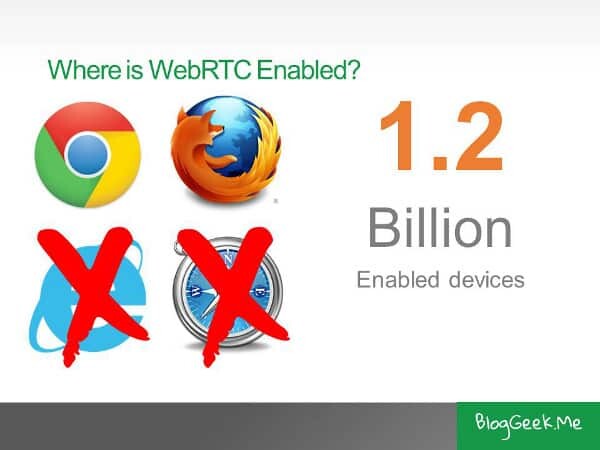I bet the house on Apple for this one.
UPDATE: Microsoft was first with Edge. Apple added WebRTC to Safari at a slow pace. Microsoft out-did Apple with announcing their future as a Chromium-based Edge browser
All this bitching and whining about the missing support of WebRTC in IE and Safari got me to write this post.

There are essentially 4 browsers in the world today: Chrome, Firefox, Internet Explorer and Safari. The rest are just comic relief.
2 of these browsers (Chrome and Firefox) already have WebRTC support in them for quite some time. Together, they have anywhere between 40-60% market share. The rest? Safari and IE hold.
There’s also a huge difference in the way these browsers release new versions:
- Chrome and Firefox get updated automatically, in release cycles of 3 months or less
- IE and Safari will usually get updated when their respective operating systems (Windows and Mac/iOS) get updated
The question though, shouldn’t be will IE and Safari ever implement WebRTC but rather when.
And the more interesting question is – who is going to be the first to get WebRTC. Safari or IE?
Microsoft Internet Explorer
Internet Explorer is a tough nut to crack. It has strongholds in some countries and within enterprises. For some many enterprises, switching from IE to another browser is close to impossible – they have already invested heavily in building their internal support systems such as ERP using ActiveX or other proprietary IE related technologies.
Microsoft has the most to lose from WebRTC. They offer both Skype and Lync – communication consumer and business solutions that don’t use WebRTC. For these services, the ability for new entrants to use WebRTC and penetrate the market is a threat. Adopting WebRTC into either Skype or Lync is a long undertaking.
That said:
- Microsoft is a member of all the relevant standardization groups
- It has been vocal about SDP in WebRTC, offering its own alternative called CU-RTC-Web
- Microsoft publicized that WebRTC’s Object RTC API (part of 2.0) is under consideration for future IE support
How will support of WebRTC in a new release of IE affect the mass deployment out there of older IE versions is a different story altogether.
Apple Safari
Apple doesn’t have a lot to lose from WebRTC.
It has FaceTime, but I don’t believe FaceTime is a real issue at Apple at the moment – they don’t release usage numbers for it, while they do release those numbers for almost all of their other services. I believe this is because the numbers aren’t high enough to meet Apple’s standards.
Apple, on the other hand, does have H.264 and is a patent holder on that codec. They probably have vested interest in H.265 as well. The fact that there’s no MTI video codec for WebRTC yet, coupled with the fact that VP8 is the only supported video codec in browsers that do support WebRTC isn’t helping in the decision making processes here.
Apple and Google shared an HTML5 rendered called WebKit. It was the engine that dealt with displaying web pages for both Safari and Chrome. A year ago, Google announced Blink, a replacement for WebKit; essentially dumping WebKit and going it alone.
Apple was left as the main maintainer of WebKit, which is a critical component of its Safari browser on both desktop and mobile.
And Apple now is… merging WebRTC related code from Blink to WebKit.
I wonder why.
When?
We’ve moved from the if question to the when question.
Can’t say I am good at predicting the future, especially not when it includes internal decision processes of large companies (never could understood those). If I had to bet (and I have betting and gambling), then these would be my predictions:
- Apple will have support for WebRTC in Safari before Microsoft will have it in IE
- Apple will go with H.264. It might add VP8 as well, but H.264 will be there
- Neither Apple nor Microsoft will have an official non-beta release in 2014
- Apple will release their support for WebRTC in 2015
- Microsoft – I have no clue
I guess I’ll be wrong in some of these predictions, but that’s life.
Why is it important?
WebRTC is here to stay. These hints from Microsoft and Apple show that they understand this as well.
For many vendors, the need for a solution on IE is critical, so this should be considered good news in the long term.
Apple joining in means better support and adoption on mobile.

Haha.. risky choice given Apple blood boils with the word “Google” (mentos in a diet coke bottle)
Anyways.. here is the point to consider if I am an enterprise with an ideal app with a workflow waiting for embedded with video or voice communications, what is my alternative – Plug-Ins.. or go back to Flash (uggghhhh!).
So here we are at OpenClove with an IE 9+ WebRTC plug-in.. which really provides the parity with the alternative or status quo for today… which will transition to native when IE or Safari deliver.
Bottomline, we “WebRTC Platform and API” players have solved the IE/Safari “delays” by providing a solution that is at par with alternatives, with a clean transition to universal WebRTC future..
KEEP CALM .. I totally agree that the “bitching and the whining” is not really necessary.. I hear it is not good for health 😉
Haha, u have lost the gamble.
2016 is coming… yet my iphone 6’s safari&chrome still not supporting. I don’t have mac though.
As for MS, IE Edge have limited support , text chat, video chat. Don’t have MS fone to test
Yap. Lost the gamble.
Prediction reversed! 😀
true